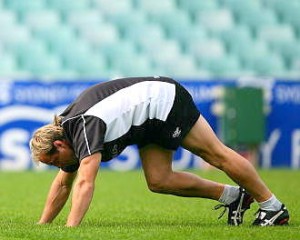5 Healing & Strengthening Moves for
the Calves and the Achilles Tendon
 1.Standing Calf Stretch
1.Standing Calf Stretch
Calf pain can be caused by many reasons including tight, weak muscles of the lower leg (gastrocnemius or soleus), or a calf muscle injury such as a calf strain or pull. This stretching program can help reduce calf pain and prevent future calf injury.
How to Do the Standing Calf Stretch
- Stand about an arm’s-length from the wall.
- Lean forward and place both hands on the wall about shoulder width apart.
- Extend one foot (the side to be stretched) behind you with heel on the ground and one foot closer to the wall.
- Lean into wall with your hips until you feel a stretch in the calf of the extended leg.
- Hold this stretch for about 30 seconds and change sides.
- For a deeper stretch, move your foot farther back.
- This stretch is similar to the Achilles tendon heel stretch, however by keeping your knee straight you focus the stretch on the calf rather than the Achilles.
 2. Standing Soleus Stretch
2. Standing Soleus Stretch
This is a very simple stretch you can do while standing. This stretch targets the soleus muscle as well as the Achilles tendon in the lower leg. Here’s how to do it correctly.
How to Do the Standing Soleus Stretch
- Take a half step forward.
- Keep your weight evenly distributed on both feet and slowly bend your knees and sink down toward the ground.
- Keep your heels on the ground.
- You will feel a stretch in the back leg, just above the heel.
- Continue to sink down slowly with your hips to deepen the stretch.
- Hold this stretch for about 30 seconds and change sides.
- By bending your knee this stretch targets the soleus and Achilles tendon rather than the gastrocnemius (calf) muscle.
 3. Full Body Calf and Achilles Stretch
3. Full Body Calf and Achilles Stretch
This is a more advanced way to stretch the back of the entire lower leg including the calf (gastrocnemius), soleus, Achilles and, to some extent, the hamstrings.
How to Do the Full Body Calf and Achilles Stretch
- If you are familiar with yoga, this stretch is very similar to the downward facing dog pose.
- Begin the stretch on your hands and knees.
- Slowly lift your knees off the floor and lift your hips up.
- Keeping one knee bend, straighten the other knee and push the heel down to the ground until you feel a stretch in the calf.
- Your heel may or may not reach the ground depending upon your flexibility — don’t force the stretch.
- Hold this stretch for 30 seconds.
- Repeat the switch on the other leg.
 4. Standing Achilles Tendon Heel Stretch
4. Standing Achilles Tendon Heel Stretch
This simple stretch, sometimes called the Achilles tendon stretch, stretches the tendons and muscles of the lower leg. Here’s how to do it correctly.
How to Do the Standing Achilles Tendon Heel Stretch
- Stand about an arm’s-length from a wall or another sturdy object.
- Lean forward and place both hands on the wall about shoulder width apart.
- Extend one foot (the side to be stretched) behind you with your knee bend and heel on the ground.
- Keep the other foot closer to the wall.
- Lean into wall slightly and bend the knee of the heel to be stretched (keeping the heel down) until you feel a stretch in the back of the lower leg (just above the heel).
- Sink down slowly with your hips to deepen the stretch.
- Hold this stretch for about 30 seconds and change sides.
- This stretch is similar to the calf stretch, however by bending your knee you focus the stretch on the Achilles rather than the calf.
 5. Foam Roller Exercise for the Calf
5. Foam Roller Exercise for the Calf
Using a foam roller to perform self massage and myofascial release not only stretches muscles and tendons but it also breaks down soft tissue adhesions and scar tissue. This particular use of the roller targets the muscles and soft tissues of the lower leg.
How to use a Foam Roller on the Calves
- Position the roller under the calves.
- Using your hands for support, slowly roll from the knee down to the ankle pausing on any tight or sore spots.
- Experiment with your toe position (in/out or pointed/flexed) to work the entire muscle group.
- Increase or decrease pressure by using one or both legs at a time, or placing one leg on the other for even more pressure.